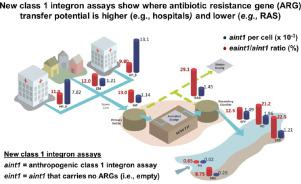Water Research ( IF 12.8 ) Pub Date : 2021-09-30 , DOI: 10.1016/j.watres.2021.117720 Marcos Quintela-Baluja 1 , Dominic Frigon 2 , M Abouelnaga 3 , Kelly Jobling 4 , Jesús L Romalde 5 , Mariano Gomez Lopez 6 , David W Graham 4

|
Class 1 and other integrons are common in wastewater networks, often being associated with antibiotic resistance genes (ARGs). However, the importance of different integron structures in ARG transfer within wastewater systems has only been implied, especially between community and hospital sources, among wastewater treatment plant compartments, and in receiving waters. This uncertainty is partly because current clinical class 1 integron qPCR assays (i.e., that target human-impacted structures, i.e., clintI1) poorly delineate clintI1 from non-impacted class 1 integron structures. They also say nothing about their ARG content. To fill these technical gaps, new real-time qPCR assays were developed for “impacted” class 1 structures (called aint1; i.e., anthropogenic class 1 integrons) and empty aint1 structures (i.e., carry no ARGs; called eaint1). The new assays and other integron assays then were used to examine integron dynamics across a wastewater network. 16S metagenomic sequencing also was performed to characterise associated microbiomes. aint1 abundances per bacterial cell were about 10 times greater in hospital wastewaters compared with other compartments, suggesting aint1 enrichment with ARGs in hospital sources. Conversely, the relative abundance of eaint1 structures were over double in recycled activated sludge compared with other compartments, except receiving waters (RAS; ∼30% of RAS class 1 structures did not carry ARGs). Microbiome analysis showed that human-associated bacterial taxa with mobile integrons also differed in RAS and river sediments. Further, class 1 integrons in RAS bacteria appear to have released ARGs, whereas hospital bacteria have accumulated ARGs. Results show that quantifying integron dynamics can help explain where ARG transfer occurs in wastewater networks, and should be considered in future studies on antibiotic resistance in the environment.
中文翻译:

废水网络中整合子结构的动力学——对抗性基因转移的影响
1 类和其他整合子在废水网络中很常见,通常与抗生素抗性基因 (ARG) 相关。然而,仅暗示了不同整合子结构在废水系统内 ARG 转移中的重要性,特别是在社区和医院来源之间、废水处理厂隔间之间以及在接收水体中。这种不确定性部分是因为当前的临床 1 类整合子 qPCR 测定(即,针对人类影响的结构,即clintI1)很难从未受影响的 1 类整合子结构中描绘出clintI1。他们也对他们的 ARG 内容只字未提。为了填补这些技术空白,针对“受影响的”1 类结构(称为aint1;即人为1类整合子)和空aint1结构(即,不携带 ARG;称为eaint1)。然后使用新的测定和其他整合子测定来检查整个废水网络的整合子动力学。还进行了 16S 宏基因组测序以表征相关微生物组。与其他隔间相比,医院废水中每个细菌细胞的aint1丰度大约是其他隔间的 10 倍,这表明在医院来源中aint1富含 ARG。相反,eaint1的相对丰度与其他隔间相比,再生活性污泥中的结构增加了一倍以上,除了接收水(RAS;约 30% 的 RAS 1 类结构不携带 ARGs)。微生物组分析表明,具有移动整合子的人类相关细菌类群在 RAS 和河流沉积物中也存在差异。此外,RAS 细菌中的 1 类整合子似乎释放了 ARG,而医院细菌则积累了 ARG。结果表明,量化整合子动力学可以帮助解释 ARG 在废水网络中转移的位置,并且应该在未来关于环境中抗生素耐药性的研究中加以考虑。



























 京公网安备 11010802027423号
京公网安备 11010802027423号